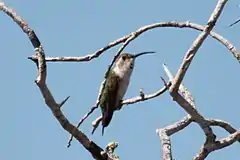| Doricha[1] | |||
| Reichenbach, 1854[2] | |||
 Przedstawiciel rodzaju – koliberek widłosterny (D. eliza) | |||
| Systematyka | |||
| Domena | |||
|---|---|---|---|
| Królestwo | |||
| Typ | |||
| Podtyp | |||
| Gromada | |||
| Podgromada | |||
| Infragromada | |||
| Rząd | |||
| Rodzina | |||
| Podrodzina | |||
| Plemię | |||
| Rodzaj |
Doricha | ||
| Typ nomenklatoryczny | |||
|
Trochilus enicurus Vieillot, 1818 | |||
| Synonimy | |||
|
| |||
| Gatunki | |||
| |||
Doricha – rodzaj ptaków z podrodziny kolibrów (Trochilinae) w rodzinie kolibrowatych (Trochilidae).
Zasięg występowania
Rodzaj obejmuje gatunki występujące od Meksyku do Salwadoru[7].
Morfologia
Długość ciała samców 9,5–12,5 cm (włącznie z długim ogonem), samic 8–9 cm; masa ciała 2,3–2,6 g[7].
Systematyka
Etymologia
- Doricha: Doricha (żyjąca w 700 roku p.n.e.), słynna grecka kurtyzana[8].
- Amathusia: w mitologii rzymskiej Amathusia była toponimem bogini Afrodyty[9]. Gatunek typowy: Trochilus enicurus Vieillot, 1818.
- Amalasia (Amalusia): alternatywna nazwa bazująca na Amathusia[10]. Gatunek typowy: Trochilus enicurus Vieillot, 1818.
- Piocercus: gr. πιων piōn, πιονος pionos „obfity, bogaty”; κερκος kerkos „ogon”[11]. Gatunek typowy: Trochilus eliza Lesson & DeLattre, 1839.
Podział systematyczny
Do rodzaju należą następujące gatunki[12]:
- Doricha enicura (Vieillot, 1818) – koliberek brzytwosterny
- Doricha eliza (Lesson & De Lattre, 1839) – koliberek widłosterny
Przypisy
- ↑ Doricha, [w:] Integrated Taxonomic Information System (ang.).
- ↑ H.G.L. Reichenbach. Aufzählung der Colibris Oder Trochilideen in ihrer wahren natürlichen Verwandtschaft, nebst Schlüssel ihrer Synonymik. „Journal für Ornithologie”. 1, s. 12, 1854. (niem.).
- ↑ É. Mulsant, J. Verreaux & E. Verreaux. Essai d’une classification méthodique des Trochilidés comprenant le catalogue de toutes les espèces connues de ces oiseaux. „Mémoires de la Société impériale des sciences naturelles de Cherbourg”. Deuxième Série. 12, s. 229, 1866. (fr.).
- ↑ É. Mulsant. Note sur les effets produits par l’extrait de colchique d’automne. „Annales de la Société Linnéenne de Lyon”. Nouvelle Série. 22, s. 225, 1875. (fr.).
- ↑ É. Mulsant & E. Verreaux: Histoire naturelle des oiseaux-mouches, ou, Colibris constituant la famille des trochilidés. Cz. 4. Lyon: Au Bureau de la Société Linnéenne, 1877, s. 15. (fr.).
- ↑ E. Simon. Notes critiques sur les Trorhilidés. „Revue Française d’Ornithologie”. 6, s. 54, 1919.
- 1 2 K.L. Schuchmann: Family Trochilidae (Hummingbirds). W: J. del Hoyo, A. Elliott & J. Sargatal: Handbook of the Birds of the World. Cz. 5: Barn-owls to Hummingbirds. Barcelona: Lynx Edicions, 1999, s. 667. ISBN 84-87334-25-3. (ang.).
- ↑ The Key to Scientific Names ↓, Doricha [dostęp 2020-04-23].
- ↑ The Key to Scientific Names ↓, Amathusia [dostęp 2020-04-23].
- ↑ The Key to Scientific Names ↓, Amalasia [dostęp 2020-04-23].
- ↑ The Key to Scientific Names ↓, Piocercus [dostęp 2020-04-23].
- ↑ Systematyka i nazwy polskie za: P. Mielczarek & M. Kuziemko: Plemię: Mellisugini Gray,GR, 1848 (wersja: 2020-03-01). [w:] Kompletna lista ptaków świata [on-line]. Instytut Nauk o Środowisku Uniwersytetu Jagiellońskiego. [dostęp 2020-04-23].
Bibliografia
- The Key to Scientific Names, J.A. Jobling (red.), [w:] Birds of the World, S.M. Billerman et al. (red.), Cornell Lab of Ornithology, Ithaca (ang.).
This article is issued from Wikipedia. The text is licensed under Creative Commons - Attribution - Sharealike. Additional terms may apply for the media files.